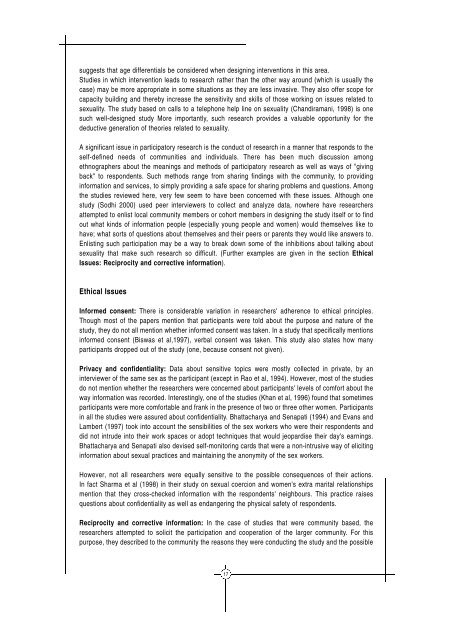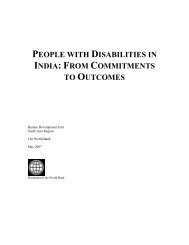FREE Download - TARSHI
FREE Download - TARSHI
FREE Download - TARSHI
You also want an ePaper? Increase the reach of your titles
YUMPU automatically turns print PDFs into web optimized ePapers that Google loves.
suggests that age differentials be considered when designing interventions in this area.<br />
Studies in which intervention leads to research rather than the other way around (which is usually the<br />
case) may be more appropriate in some situations as they are less invasive. They also offer scope for<br />
capacity building and thereby increase the sensitivity and skills of those working on issues related to<br />
sexuality. The study based on calls to a telephone help line on sexuality (Chandiramani, 1998) is one<br />
such well-designed study More importantly, such research provides a valuable opportunity for the<br />
deductive generation of theories related to sexuality.<br />
A significant issue in participatory research is the conduct of research in a manner that responds to the<br />
self-defined needs of communities and individuals. There has been much discussion among<br />
ethnographers about the meanings and methods of participatory research as well as ways of "giving<br />
back" to respondents. Such methods range from sharing findings with the community, to providing<br />
information and services, to simply providing a safe space for sharing problems and questions. Among<br />
the studies reviewed here, very few seem to have been concerned with these issues. Although one<br />
study (Sodhi 2000) used peer interviewers to collect and analyze data, nowhere have researchers<br />
attempted to enlist local community members or cohort members in designing the study itself or to find<br />
out what kinds of information people (especially young people and women) would themselves like to<br />
have; what sorts of questions about themselves and their peers or parents they would like answers to.<br />
Enlisting such participation may be a way to break down some of the inhibitions about talking about<br />
sexuality that make such research so difficult. (Further examples are given in the section Ethical<br />
Issues: Reciprocity and corrective information).<br />
Ethical Issues<br />
Informed consent: There is considerable variation in researchers' adherence to ethical principles.<br />
Though most of the papers mention that participants were told about the purpose and nature of the<br />
study, they do not all mention whether informed consent was taken. In a study that specifically mentions<br />
informed consent (Biswas et al,1997), verbal consent was taken. This study also states how many<br />
participants dropped out of the study (one, because consent not given).<br />
Privacy and confidentiality: Data about sensitive topics were mostly collected in private, by an<br />
interviewer of the same sex as the participant (except in Rao et al, 1994). However, most of the studies<br />
do not mention whether the researchers were concerned about participants' levels of comfort about the<br />
way information was recorded. Interestingly, one of the studies (Khan et al, 1996) found that sometimes<br />
participants were more comfortable and frank in the presence of two or three other women. Participants<br />
in all the studies were assured about confidentiality. Bhattacharya and Senapati (1994) and Evans and<br />
Lambert (1997) took into account the sensibilities of the sex workers who were their respondents and<br />
did not intrude into their work spaces or adopt techniques that would jeopardise their day's earnings.<br />
Bhattacharya and Senapati also devised self-monitoring cards that were a non-intrusive way of eliciting<br />
information about sexual practices and maintaining the anonymity of the sex workers.<br />
However, not all researchers were equally sensitive to the possible consequences of their actions.<br />
In fact Sharma et al (1998) in their study on sexual coercion and women's extra marital relationships<br />
mention that they cross-checked information with the respondents' neighbours. This practice raises<br />
questions about confidentiality as well as endangering the physical safety of respondents.<br />
Reciprocity and corrective information: In the case of studies that were community based, the<br />
researchers attempted to solicit the participation and cooperation of the larger community. For this<br />
purpose, they described to the community the reasons they were conducting the study and the possible<br />
17










